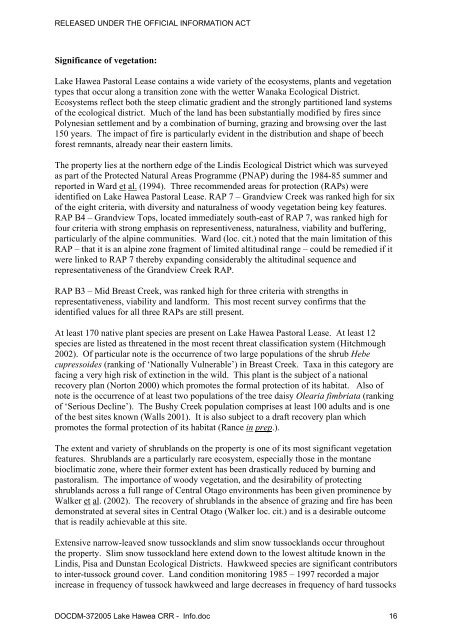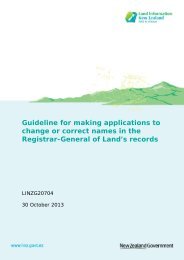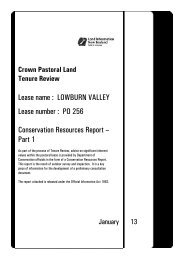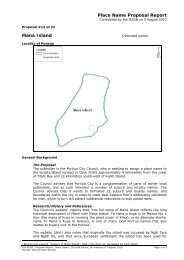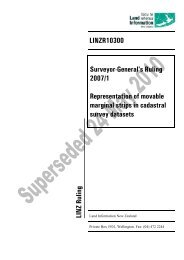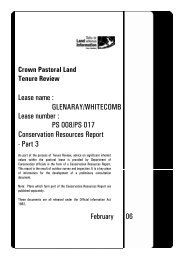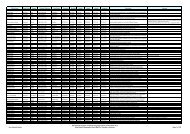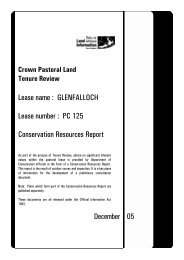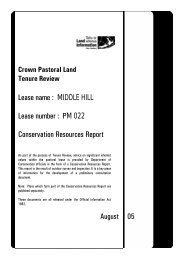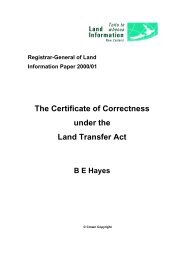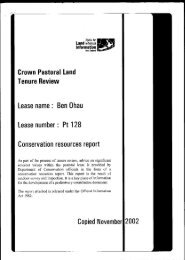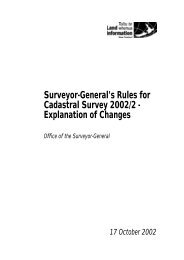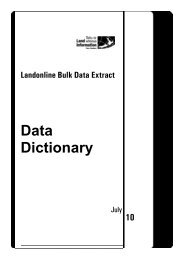Crown Pastoral-Tenure Review-Lake Hawea-Conservation ...
Crown Pastoral-Tenure Review-Lake Hawea-Conservation ...
Crown Pastoral-Tenure Review-Lake Hawea-Conservation ...
Create successful ePaper yourself
Turn your PDF publications into a flip-book with our unique Google optimized e-Paper software.
RELEASED UNDER THE OFFICIAL INFORMATION ACT<br />
Significance of vegetation:<br />
<strong>Lake</strong> <strong>Hawea</strong> <strong>Pastoral</strong> Lease contains a wide variety of the ecosystems, plants and vegetation<br />
types that occur along a transition zone with the wetter Wanaka Ecological District.<br />
Ecosystems reflect both the steep climatic gradient and the strongly partitioned land systems<br />
of the ecological district. Much of the land has been substantially modified by fires since<br />
Polynesian settlement and by a combination of burning, grazing and browsing over the last<br />
150 years. The impact of fire is particularly evident in the distribution and shape of beech<br />
forest remnants, already near their eastern limits.<br />
The property lies at the northern edge of the Lindis Ecological District which was surveyed<br />
as part of the Protected Natural Areas Programme (PNAP) during the 1984-85 summer and<br />
reported in Ward et al. (1994). Three recommended areas for protection (RAPs) were<br />
identified on <strong>Lake</strong> <strong>Hawea</strong> <strong>Pastoral</strong> Lease. RAP 7 – Grandview Creek was ranked high for six<br />
of the eight criteria, with diversity and naturalness of woody vegetation being key features.<br />
RAP B4 – Grandview Tops, located immediately south-east of RAP 7, was ranked high for<br />
four criteria with strong emphasis on representiveness, naturalness, viability and buffering,<br />
particularly of the alpine communities. Ward (loc. cit.) noted that the main limitation of this<br />
RAP – that it is an alpine zone fragment of limited altitudinal range – could be remedied if it<br />
were linked to RAP 7 thereby expanding considerably the altitudinal sequence and<br />
representativeness of the Grandview Creek RAP.<br />
RAP B3 – Mid Breast Creek, was ranked high for three criteria with strengths in<br />
representativeness, viability and landform. This most recent survey confirms that the<br />
identified values for all three RAPs are still present.<br />
At least 170 native plant species are present on <strong>Lake</strong> <strong>Hawea</strong> <strong>Pastoral</strong> Lease. At least 12<br />
species are listed as threatened in the most recent threat classification system (Hitchmough<br />
2002). Of particular note is the occurrence of two large populations of the shrub Hebe<br />
cupressoides (ranking of ‘Nationally Vulnerable’) in Breast Creek. Taxa in this category are<br />
facing a very high risk of extinction in the wild. This plant is the subject of a national<br />
recovery plan (Norton 2000) which promotes the formal protection of its habitat. Also of<br />
note is the occurrence of at least two populations of the tree daisy Olearia fimbriata (ranking<br />
of ‘Serious Decline’). The Bushy Creek population comprises at least 100 adults and is one<br />
of the best sites known (Walls 2001). It is also subject to a draft recovery plan which<br />
promotes the formal protection of its habitat (Rance in prep.).<br />
The extent and variety of shrublands on the property is one of its most significant vegetation<br />
features. Shrublands are a particularly rare ecosystem, especially those in the montane<br />
bioclimatic zone, where their former extent has been drastically reduced by burning and<br />
pastoralism. The importance of woody vegetation, and the desirability of protecting<br />
shrublands across a full range of Central Otago environments has been given prominence by<br />
Walker et al. (2002). The recovery of shrublands in the absence of grazing and fire has been<br />
demonstrated at several sites in Central Otago (Walker loc. cit.) and is a desirable outcome<br />
that is readily achievable at this site.<br />
Extensive narrow-leaved snow tussocklands and slim snow tussocklands occur throughout<br />
the property. Slim snow tussockland here extend down to the lowest altitude known in the<br />
Lindis, Pisa and Dunstan Ecological Districts. Hawkweed species are significant contributors<br />
to inter-tussock ground cover. Land condition monitoring 1985 – 1997 recorded a major<br />
increase in frequency of tussock hawkweed and large decreases in frequency of hard tussocks<br />
DOCDM-372005 <strong>Lake</strong> <strong>Hawea</strong> CRR - Info.doc 16


